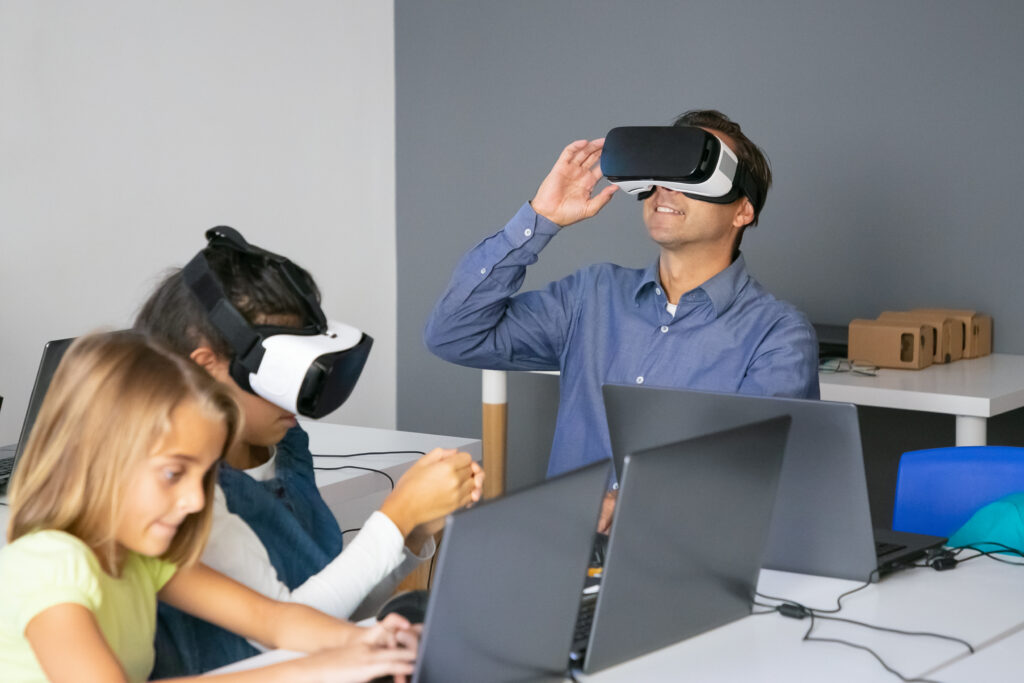The lines between reality and the virtual realm are becoming increasingly blurred. 2023 has witnessed an explosion in how Virtual Reality (VR) and Augmented Reality (AR) are reshaping not just our entertainment, but also our work, training, and learning environments. As we journey through this ever-evolving virtual frontier, let’s explore the expansive potential of VR and AR.
Setting the Stage: VR vs. AR
Before diving deep, it’s essential to understand the distinctions:
- Virtual Reality (VR): A fully immersive experience, VR takes users into a computer-generated environment, isolating them from the real world. Equipped with VR headsets, users can interact with this environment in real-time.
- Augmented Reality (AR): Instead of a complete immersion, AR overlays digital content onto the real world. Through AR glasses or smartphone cameras, users can engage with these digital augmentations, integrating virtual elements into their reality.

Gaming: More Than Just Play
Gaming is the most recognizable application of VR and AR, transforming how we interact with virtual worlds:
- Immersion Like Never Before: Gone are the days of merely observing game worlds. With VR, players are in the game. This immersive experience offers unparalleled depth, from exploring fantastical terrains to engaging in intense combat sequences.
- Interactive AR Gaming: Games like Pokémon GO gave us a taste of AR’s potential. Now, city streets become treasure hunts, parks turn into battlegrounds, and our everyday world is reimagined as a playground.
- Social & Collaborative Gaming: Multiplayer VR games, such as VRChat, enable players to socialize in virtual spaces, making digital interactions feel as genuine as real-life encounters.
Training & Learning: Virtual Practice, Real Mastery
Beyond entertainment, VR and AR are proving invaluable in training and educational scenarios:
- Medical Training: VR simulations allow medical students to practice surgeries or diagnose conditions in a risk-free environment, offering hands-on experience without real-world consequences.
- Military & First Responders: VR scenarios can simulate crisis situations, preparing soldiers, firefighters, or police officers for the challenges they might face, from intense combat to disaster response.
- Corporate Training: From customer service role-playing to machinery operation, VR provides employees a practice ground, ensuring they’re ready for real-world tasks.
- Educational Augmentations: Imagine a history lesson where students can virtually visit ancient civilizations or a biology class where cellular structures are explored in 3D through AR. The potential to enhance understanding and retention is profound.
Challenges & Considerations
Despite the promise, the world of VR and AR isn’t without its hurdles:
- Physical & Psychological Effects: Prolonged VR usage can lead to motion sickness or disorientation. There’s also a need to study the long-term psychological effects of extended immersion.
- Technical Limitations: High-quality VR requires powerful hardware. While advancements are continual, there’s a balance to strike between performance and accessibility.
- Content Creation: Developing compelling VR and AR experiences requires a blend of storytelling, technical prowess, and design acumen. The evolution of content creation tools and platforms will be pivotal.
Towards a Merged Reality
The essence of VR and AR lies in merging realities—whether it’s integrating the digital into the real or diving deep into virtual realms. As technologies advance and become more ingrained in our daily lives, the dichotomy between the virtual and the real will fade. We’re standing on the precipice of a world where our realities are tailored, enhanced, and redefined.
In Conclusion
The year 2023 isn’t just about new gadgets or improved graphics; it’s about redefining boundaries. As VR and AR technologies mature and become more accessible, they promise a future where learning, play, work, and socialization converge in expansive virtual landscapes and augmented realities. The frontier is vast, and the journey has just begun.